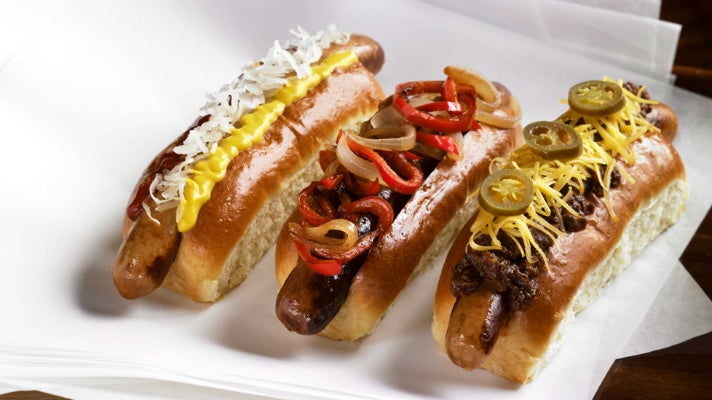There are no shortage of huts, stands, storefronts, butchers and specialty eateries serving sausage these days. While many simply purchase products off the shelf from wholesalers, others work much more closely with their purveyors to develop or execute recipes and techniques passed down through generations or learned from honing their craft in kitchens the world over.
Many people are surprised to learn that even some of the most famous sausage spots outsource to butchers. The reasons for it are many, but it comes down to a combination of the time, space and labor involved in the production process, not to mention the equipment. In short, it’s a grind, so it’s best to leave it to the pros.
FRITZI DOG
Neal Fraser is best known for his beloved fine-dining restaurant Grace, which will eventually reopen at Vibiana Downtown. In the meantime, the classically trained chef has turned his attention to food typically considered more lowbrow. As the executive chef of Fritzi Dog at the Farmers Market, he’s bringing a gourmet aspect to the typical hot dog experience.
But he’s also keeping it simple: only five dogs and four Rockenwagner Bakery buns. The recipes represent variations on many Fraser has been fine-tuning for years. The signature beef and pork Fritzi Dog, for instance combines influences culled from a lamb sausage he perfected at Checkers while working for Thomas Keller, and the Chilean spice merken, which he discovered while hosting a South American chef at Grace. That said, Fraser assures, “they are unique without being too unique—we don’t want to scare our audience away, especially at the [tourist-friendly] Farmers Market.
Fraser also likes to quip there are no “lips or asses” used in the product, only “primal” meats. Two of the wieners are fully emulsified, more traditional hot dogs. Others are only partially emulsified, so that there can—and should—be variation in bites. If you slice into them, it’s clearly not a puree; instead there are visible fragments of the herbs, spices and meats. As Fraser points out, “With variation of texture you also get a variation of flavor. Each bite is a little different based on the fat-to-spice ratio.” Try all five as part of the mini four-inch “tasting dogs.”
SEOUL SAUSAGE COMPANY

From its auspicious beginnings at the LA Street Food Festival in 2010 to its victory on the third season of Food Network reality cooking competition The Great Food Truck Race, Seoul Sausage opened its storefront doors October 6, 2012. Located in Sawtelle Japantown, an area traditionally known for Japanese food, Seoul Sausage is part of a new crop of restaurants pushing culinary boundaries both for the neighborhood and for Korean fusion food in general.
The inspiration suggests that perhaps encapsulating the Korean barbecue experience in a sausage format was part of a larger foodie manifest destiny. Co-owner Yong Kim says, “We were inspired by the Kogi taco. They infused a classic Mexican dish with Korean flavors. A lot of companies do sausage with kimchi condiments. Ours is the first to flavor and case Korean spices within a sausage. It’s a byproduct of where we are in terms of our palates in LA."
The menu is small, but focused. For now, only two sausages are served: kalbi beef with kimchi relish and garlic jalapeno aioli, and spicy pork with apple cabbage slaw. The pairings are very specific and intentional; so don’t expect the usual assortment of condiment options. Co-owner Yong Kim compares the mentality to that of the Father’s Office burger. It should be noted that the custom-made buns approach perfection.
BIERBEISL

Chef Bernhard Mairinger is passionate about what he calls Modern Austrian cuisine, but when it comes to his sausage recipes, he’s more of a traditionalist, particularly because he loves introducing Angelenos to specialty blends most have never seen before. Two unique staples on his sausage menu are the debreziner, a spicy and thin sausage; and the thicker käsekrainer—Mairinger’s personal favorite—which is infused with emmental cheese. Beer-pairing suggestions are on the menu.
The recipes came from a butcher shop that chef worked at in his native Austria. When he was ready to open his own restaurant, he then played around a bit with the ingredients, “a little more here, a little less there.” But the actual sausage production comes from Continental in Glendale.
Mairinger says, “I worked with [Continental owner] Eugene Goetz for about a week…we went over the recipes, how the cheese gets folded in, what casing we’re going to use. We tried the first batch, talked about flavor, what needed to change. After a few times, we pretty much had it.”
RED LION TAVERN
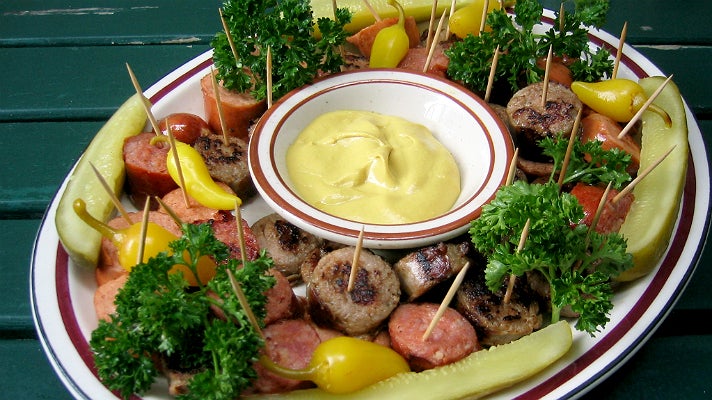
The Red Lion has been a fixture in Silver Lake for more than 50 years. While they don’t officially claim to be the oldest German restaurant in LA still in operation, they “probably” are. It’s the kind of place where locals gather to watch sports; strike up conversations with strangers, ogle the buxom waitresses in their traditional drindle dresses—and where the mantra of “let’s get sausages and beer,” is a familiar refrain.
By far, the most popular dish at the German “gasthaus” and beer garden is the schlachtplatte, or sausage platter, which includes slices of bratwurst, knackwurst and smoked Polish bockwurst, served with mustard, peppers and pickles. No one knows for sure, but the recipes for the sausages have likely been the same since the ‘80s. The supplier certainly has, since the former owner of Continental and the former proprietor of the Red Lion were good friends. And the tradition will live on now that the majority shareholder in each is the same person.
CONTINENTAL GOURMET SAUSAGE COMPANY
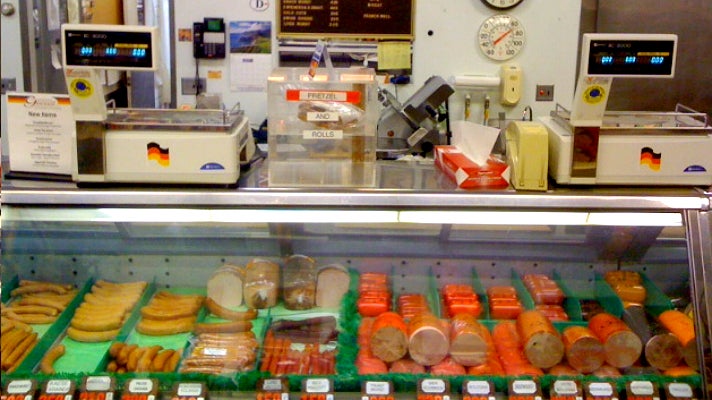
Aidas Mattis was a loyal Red Lion customer long before he ever considered buying the place. He’s actually Lithuanian, not German, but jokes that it’s “as close to German as an Eastern European can get.” In fact, the venue has long hosted many of his countrymen on Sundays, following church services at the nearby St. Casimir parish in Los Feliz.
In 2004, he took over ownership of the bar, after the previous proprietor passed away. In late 2011, Continental owner Eugene Goetz was approaching retirement and realized that his legacy would be best preserved if his business and his biggest client basically merged.
Training sessions with Goetz have assured that Mattis and his partners will indeed continue the legacy of the “stubborn old German,” who amassed an entire wall of trophies and ribbons through his success is sausage competitions over the years. It’s good news for the many eateries serviced by Continental, including Atwater’s Link-n-Hops, not to mention the many area families who regularly stop by the retail store for umpteen different varies of sausage, including Hungarian kolbasa, Swiss bockwurst, Polish kielbasa and Cajun andouille.
BRAT BROS.
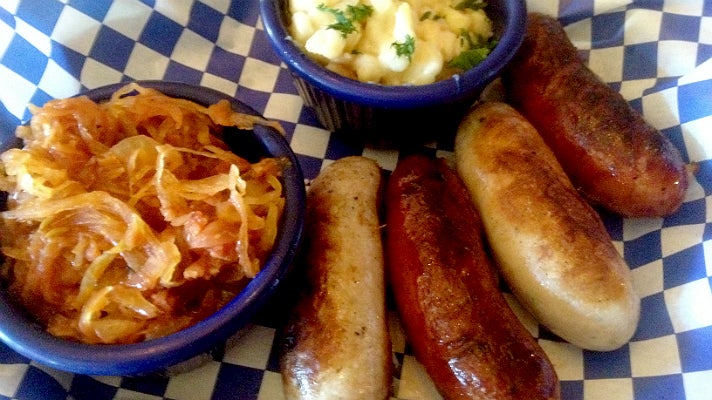
When Roland Radler first opened the original Brat Bros. location in 2007, he never dreamed that his Bavarian fast food concept would one day be featured on the Guy Fieri hit Diners, Drive-Ins and Dives. All of a sudden the popular neighborhood eatery was packed with lines out the door. Not only that, but customers lingered longer than he had anticipated, and they wanted brews to enjoy with their brats and bros. As soon as he got the chance, he moved up the street to a larger location and secured a beer and wine license.
A Hancock Park native, Radler’s family moved to Munich when he was 12, where he eventually studied architecture and engineering, later returning to LA to build high-end homes. Sensing the economic tide turning in his industry, he decided to change fields to pursue his love of cooking. After many trips back to Munich scouting out great sausage restaurants and specialty butchers, he was armed with recipes that he later tweaked for the U.S. market. There are now a total of 27 sausages on the menu, including everything from traditional German and Polish varieties to more exotic flavors like kangaroo and alligator.
Rather than outsource the actual prep to a local butcher, he rents out a USDA-inspected facility during off hours, when his guys go in and produce a whopping 1,500 to 2,000 pounds per week. That number will likely double—or even triple—once the second location of Brat Bros. opens in Thousand Oaks in December.
STEINGARTEN LA

Don’t think of Steingarten as a European biergarten concept imported to LA. Think of it as its submoniker suggests: “California’s beer garden.” It’s not about lederhosen and an everyday Oktoberfest, it’s about exacting standards on the sausages, with vendors under exclusive contract to execute the many proprietary recipes. And there are no less than two-dozen varieties, from a very approachable basic bratwurst and chicken apple to a whole section of game like venison and wild boar. There are also vegan options that come from Oregon, and the kosher sausages are sourced from a certified kosher butcher.
And co-owner Abbey Berookhim is always pushing culinary boundaries. At the moment, he’s tinkering with a new sausage for the holidays. He says, “I’m designing a new one for Christmas. A turkey sausage with caramelized onions and raisins ... That’s my project at the moment.”
His day-to-day work, however, finds him walking the floor of his restaurant, chatting up regulars. Fittingly, the casual vibe befits the neighborhood, with many families dining early in the evening, making room for beer and whiskey lovers later on—the brew menu boasts 120 selections and the brown spirits list is impressively deep as well.
BERLIN CURRYWURST
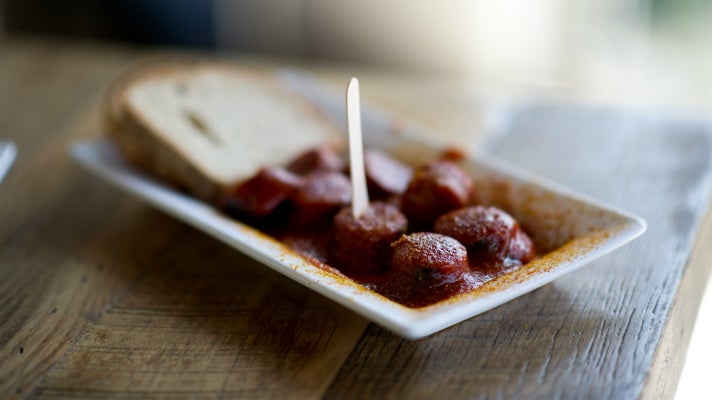
People love the story behind Berlin Currywurst. It’s the ultimate American Dream scenario coupled with camera-ready good looks. An attractive young couple emigrates from Germany and follows their dreams to Los Angeles, launching a never-before-seen restaurant concept and manages to open in record time—and is soon to expand the business to Hollywood.
Hardeep and Lena Manak had visited LA many times on vacation and were surprised to find that traditional currywurst didn’t exist here. To the uninitiated, currywurst is basically pork sausage with a curry-based tomato sauce on top. Hardeep Manak says, “It is the most traditional street food in Germany. The curry was brought in by the British after the end of World War II. Currywurst was invented by a German housewife named Herta Heuwer in 1949. It started as a stand and became more and more popular.”
Even though it’s only been open since February 2011—only three months after the Manaks moved to LA—it already feels like an institution in Silver Lake. The community quickly embraced the concept, and its location was no lucky accident. Manak says, “Silver Lake has a specific vibe for LA like what we have in the Kreuzberg [neighborhood] in Berlin. It’s hip, young and open to new concepts.” And that’s important to Manak, because his message is “not a clichéd picture of Germany,” but an authentic representation “of how the youth culture in Berlin is these days.”
Ordering is a multi-step process. There are six kinds of meat sausages and two vegan options; so first diners choose a protein, then a spice level and finally a flavor, which could be fruity, chipotle, jambalaya, garlic or ginger-orange. According to Manak, one of the most popular is the paprikawurst with ginger-orange.
JODY MARONI’S SAUSAGE KINGDOM

Jody Maroni’s sausage stand has been a Venice landmark since 1979, when the namesake owner set up a barbecue grill on the boardwalk and began peddling his product to eager passersby. Originally, there were only a couple Italian sausages offered, but over the years, many different varieties were added based on “Maroni’s” studies and travels. There are presently five core sausages—the original two hot and sweet Italian, chicken apple, bratwurst and andouille—plus a few exotics that rotate in and out, such as chicken mole with chocolate, cumin and chile.
The man behind the legend is Jordan Monkarsh, whose roots are actually Jewish, not Italian. It is said that he was “born into the world of meat,” since his father owned a highly regarded butcher shop in the San Fernando Valley. Operating under the belief that no one would buy Italian sausage from a Jewish guy, Monkarsh created the pseudonym that spawned a kingdom. Though Jody himself hasn’t been involved in the day-to-day operations since 2011, he still consults and is still the face of the restaurant; his children are the majority shareholders. There are additional Los Angeles-area locations at Universal CityWalk Hollywood and Terminal Six at LAX.
INFO
Berlin Currywurst
3827 W. Sunset Blvd., Silver Lake, 323.663.1989
www.berlincurrywurst.com
BierBeisl
9669 Santa Monica Blvd., Beverly Hills, 310.271.7274
www.bierbeisl-la.com
Brat Bros.
13355 Ventura Blvd., Sherman Oaks, 818.986.4020
bratsbrothers.com
Continental Gourmet Sausage Company
6406 San Fernando Rd., Glendale, 818.502.1447
continentalgourmetsausage.com
Fritzi Dog
6333 W. 3rd St., Los Angeles, 310.555.5500
www.fritzidog.com
Jody Maroni’s Sausage Kingdom
2011 Ocean Front Walk, Venice, 310.822.5639
www.jodymaroni.com
Red Lion Tavern
2366 Glendale Blvd., Silver Lake, 323.662.5337
www.redliontavern.net
Seoul Sausage Company
11313 Mississippi Ave., West LA, 310.477.7739
www.seoulsausage.com
Steingarten LA
10543 W. Pico Blvd., West LA, 310.441.0441
www.steingartenla.com



